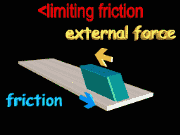The definition of friction
Friction is the name given to the force which opposes the relative sliding motion of two surfaces in contact with one another. It plays a notable part in our daily lives. For example, we are reminded of the importance of friction every time we slip up on an icy pavement or a polished floor. Waking would be impossible if there is no friction between the ground and the soles of our shoes. If the pavements were perfectly frictionless the only way we could get about would be with the aid of pegs in the soles of our shoes and holes in the pavements to correspond. quite often our lives depend on the force of friction in the brakes for an automobile or a railway train. About 20% of the gasoline used in an automobile is needed to counteract friction in the engine and in the drive train.
There are two technical terms used in the study of friction :
1- Limiting ( static ) friction


Consider a rectangular block of wood placed on a flat surface, this block has a string and spring dynamo-meter, i.e., a balance calibrated for horizontal use, attached to it so that a horizontal force can be applied.
If a gradually increasing force is applied to the block it will, at first, continue to remain at rest since an equally increasing but oppositely directed force of friction F, comes into action at the under surface of the block. At any particular moment, we say that the pull P and the opposing frictional force F are in equilibrium.
If we continue to increase the pull P, a stage will be reached when the block just begins to slip. At this point, the friction brought into play has reaches its maximum value for the two surfaces concerned, and this is called the limiting friction.
2- Dynamic friction
If the block is pulled along so that it slips at a steady speed we notice that the dynamo-meter gives a reading rather less than the limiting friction. Dynamic ( sliding ) friction is, therefore, less than limiting ( static ) friction. Thus, if you wish the block to move across the surface with a constant speed, you must usually decrease the magnitude of the applied force once the block begins to move.
applied force once the block begins to move.
Coefficient of friction
If the simple experiments we have described are repeated with various weights on the block it is found that both the limiting and the dynamic friction are increased roughly in simple proportion to the force, perpendicular to the surfaces, which is pressing them together.
The ratios of the limiting and dynamic friction to the force pressing the surfaces together are called the coefficients of static and dynamic friction respectively. Coefficient of friction is denoted by the Greek letter µ ( mu ). Thus,
µ = F / R
which F = force of friction and R = force pressing surfaces together.
In the seventeenth century these coefficients were thought to be constants, but we now know that this is far from being the case especially under conditions of fast slipping and high contact pressure.
Now, what is the nature of friction ?
We shall now discuss briefly – 🙂 – the nature of frictional force. Primarily it depends on the composition of the surfaces, and we are here concerned with the friction between certain smooth surfaces rather than the obvious interlocking of projections which occurs with rough surfaces.
Much researches has been done on the subject of friction from which it appears that attractive force between the surfaces molecules plays a major part.
Generally speaking, traces of grease, dust, or other contamination reduce friction considerably.
We can illustrate this by a simple experiment in the case of glass. Ordinary glass tubing, even it looks clean, will usually carry an invisible film of dirt. Also, air will have soaked into the surface of the glass. The absorption of gases by solids in this way is called occlusion or adsorption. This surface contamination acts as a lubricant so, if one piece of tubing is drawn across another it slips quite easily.
If a piece of glass tubing is now heated and drawn out in a Bunsen flame the occluded air and other surface contamination are driven off and a fresh clean surface results. By drawing one such piece of tubing across another, the greatly increased friction can readily be felt, even when the top piece rests on the lower merely by its own weight. Indeed, the mutual attraction of the surface molecules in contact can be as great as that between those in the body of the glass itself. They may be torn away from their neighbors so that the two pieces of glass scratch one another.

